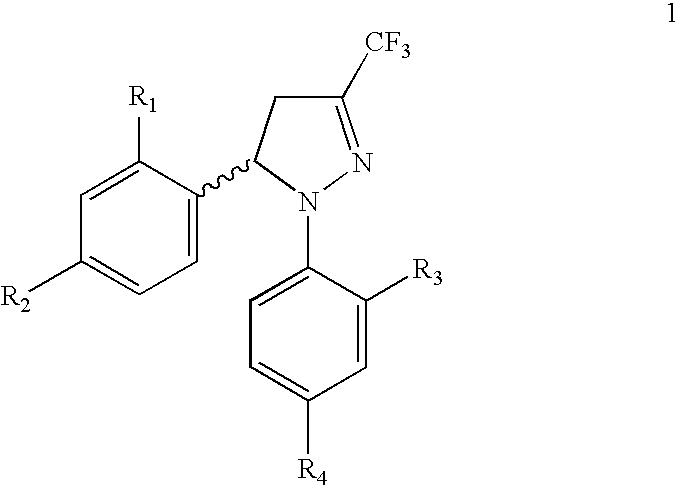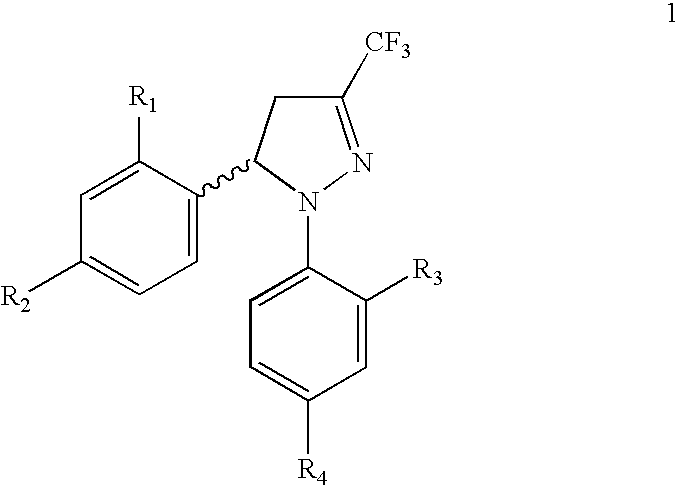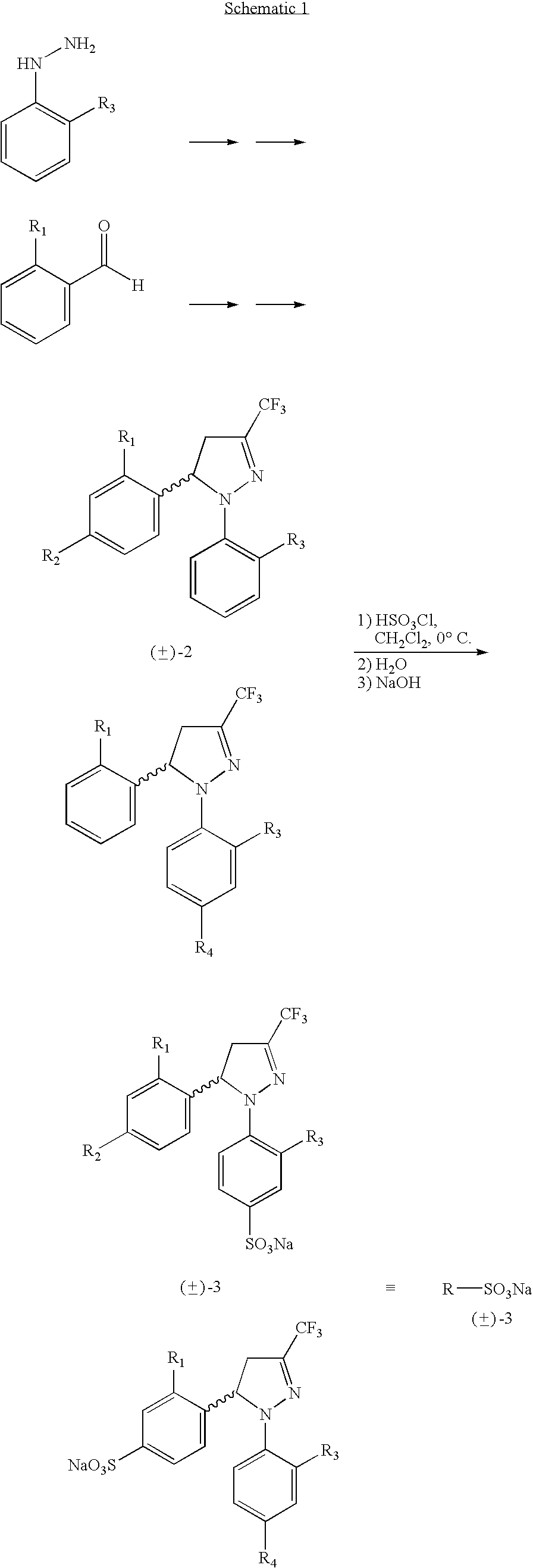Procedure for the preparation of racemic derivatives of 1,5-diaryl-3-trifluoromethyl-delta2-pyrazolines
a technology of trifluoromethyl-delta2 and racemic derivatives, which is applied in the field of preparation of racemic derivatives of 1, 5diaryl3trifluoromethyldelta2pyrazolines, can solve problems such as reducing yields
- Summary
- Abstract
- Description
- Claims
- Application Information
AI Technical Summary
Benefits of technology
Problems solved by technology
Method used
Image
Examples
example 1
Preparation of (−)-4-[5-(2,4-difluorophenyl)-4,5-dihydro-3-(trifluoromethyl)-1H-pyrazol-1-il]-benzenosulphonamide, (−)-8
Preparation of (±)-1-phenyl-5-(2,4-difluorophenyl)-4,5-dihydro-3-trifluoromethyl-1H-pyrazol, (±)-5
[0028]
[0029] In a 50 mL beaker are introduced (E)-1,1-trifluoro-4-(2,4-difluorophenyl)-3-buten-2-one (2.66 g, 11.2 mmol), monohydrated p-toluensulphonic acid (2.1 g, 11.2 mmol) and phenylhydrazine chlorhydrate (1.33 g, 12.3 mmol) and heated to 110° C. A small amount of ethyl alcohol can be used to facilitate the initial mixture. After approximately 2 h (control by CCF) the mixture is allowed to cool and it is diluted with ethyl acetate. It is then washed with a saturated solution of NaHCO3, dried with MgSO4, filtered and the solvent evaporated at low pressure. The crude thus obtained (3.9 g) is recrystallised with methanol (2 mL) to precipitate 3.67 g (65%) of the pyrazoline (±)-5: pf=83-84° C.; IR (KBr) μ max (cm−1) 1600, 1505, 1326; 1H-RMN (CDCl3) 8 (ppm): 7.28-6.7...
example 2
Preparation of (−)-1-(2,4-difluorophenyl)-4,5-dihydro-5-(4-methylsulphonylphenyl)-3-(trifluoromethyl)-1H-pyrazol, (−)-13
Preparation of (±)-1-(2,4-difluorophenyl)-4,5-dihydro-5-phenyl-3-(trifluoromethyl)-1H-pyrazol, (±)-10
[0039]
[0040] In a 50 mL beaker are introduced (E)-1,1,1-trifluoro-5-phenyl-3-buten-2-one (3.04 g, 15.2 mmol), monohydrated p-toluensulphonic acid (2.9 g, 15.2 mmol) and 2,4-difluorophenylhydrazine chlorhydrate (3.01 g, 16.7 mmol) and heated to 110° C. A small amount of ethyl alcohol can be used to facilitate the initial mixture. After approximately 2 hour (controlled by CCF) the mixture is allowed to cool and it is diluted with ethyl acetate. It is washed with a saturated solution of NaHCO3, dried with MgSO4, filtered and the solvent is evaporated at low pressure. The crude thus obtained is recrystallised with isopropyl alcohol (1 g / 1 mL) precipitating 3.95 g (80%) of pyrazoline (±)-10: pf=52-54° C.; IR (KBr) μ max (cm−1) 1598, 1511, 1414, 1324; 1H-RMN (CDCl3) δ (p...
PUM
| Property | Measurement | Unit |
|---|---|---|
| temperature | aaaaa | aaaaa |
| temperature | aaaaa | aaaaa |
| flow rate | aaaaa | aaaaa |
Abstract
Description
Claims
Application Information
 Login to View More
Login to View More - R&D
- Intellectual Property
- Life Sciences
- Materials
- Tech Scout
- Unparalleled Data Quality
- Higher Quality Content
- 60% Fewer Hallucinations
Browse by: Latest US Patents, China's latest patents, Technical Efficacy Thesaurus, Application Domain, Technology Topic, Popular Technical Reports.
© 2025 PatSnap. All rights reserved.Legal|Privacy policy|Modern Slavery Act Transparency Statement|Sitemap|About US| Contact US: help@patsnap.com



